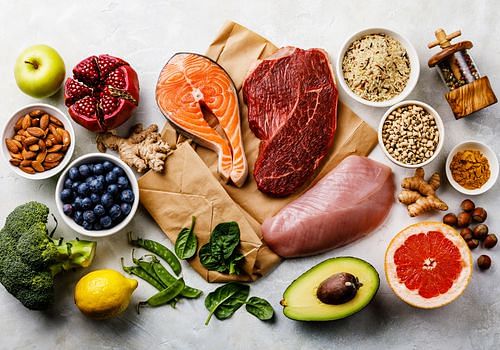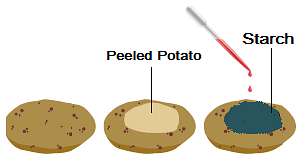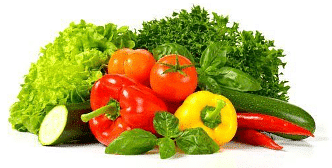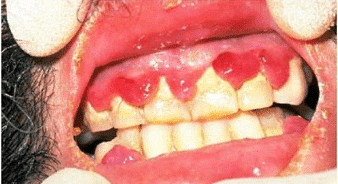Components of Food Class 6 Notes Science Chapter 1
| Table of contents |

|
| Food |

|
| Nutrition |

|
| Diet |

|
| Malnutrition |

|
| What do different Food Items Contain? |

|
| Test for Starch |

|
| Test for Protein |

|
| What do Various Nutrients do to our Body? |

|
| Balanced Diet |

|
| Deficiency Diseases |

|
We eat different types of vegetables, fruits, cereals and pulses. We all eat food to obtain energy for our daily activities. There are different components of food and each of these components is required by our body to perform different cellular activities.
Food
It is the group of edible substances which provide energy to living beings and repair the old tissues and build the new tissues.
Nutrition
The process of consuming nutrients required for the growth and development of our body and to obtain energy is known as nutrition.
 A nutrient rich diet
A nutrient rich diet
Diet
It is the amount of food eaten by a person at a time.
Malnutrition
If a person does not get adequate food or if his/her diet does not contain all the nutrients, he or she becomes weak. When the body does not get adequate nutrition, it is said to be suffering from malnutrition.
What do different Food Items Contain?
- Different food items contain different types of nutrients.
 Different Nutrients
Different Nutrients
- Nutrients are chemical components in food that are required for releasing energy and helps in growth.
- Carbohydrates, proteins, fats, vitamins and minerals are important nutrients found in food.
- Carbohydrates and fats mainly provide energy.
- Proteins mainly help in growth.
- Starch and sugar are the two kinds of carbohydrates found in food.
Test for Starch
- Take small quantity of the food items to be tested.
- Put 2-3 drops of iodine solution on it.
- Observe the colour of the food item.
- Blue-black colour indicates the presence of starch in the tested food item.
 Starch Test on Potato
Starch Test on Potato
Test for Protein
- Take a small quantity of the food items to be tested.
- Grind/mash/paste/powder the food item.
- Put the food item into a test tube.
- Add 10 drops of water to the test tube.
- Add two drops of copper sulphate solution to the test tube.
- Add 10 drops of caustic soda solution and shake the test tube.
- Observe the colour of the mixture.
- Violet colour indicates the presence of proteins in the tested food item.
 Test for Protein
Test for Protein
Test for Fats
- Take a small quantity of the food item to be tested.
- Wrap the food item in a small piece of paper.
- Crush the food item wrapped in the paper.
- Straighten the paper.
- Dry the paper by keeping it in sunlight for a while.
- Observe the paper.
- An oily patch on the paper indicates the presence of fats in the tested food item.
What do Various Nutrients do to our Body?
All living organisms require food. Food has six types of nutrients: carbohydrates, proteins, fats, vitamins, minerals and water.
These are essential to perform all daily and metabolic activities.
(i) Carbohydrates
Carbohydrates are compounds of carbon, hydrogen and oxygen, always in the ratio of 1:2:1.
- They are oxidized in the cells to release energy. Carbohydrates include sugars, starch and cellulose.
- Carbohydrates are oxidized in the body in the form of sugars. They provide instant energy.
- When oxidized in the body, one mole of glucose releases 686 kilo-calories of energy.
- They are mainly present in rice, potato, banana, etc.
(ii) Proteins
Proteins are composed of carbon, hydrogen, oxygen and nitrogen.
- Nitrogen is the most essential element in proteins. Some proteins contain sulphur and phosphorus.
 Vegetables
Vegetables
- Amino acids are the simple, smaller units of proteins. Proteins provide chemical material for the growth and repair of the body cells and tissues.
- In an emergency, they may also oxidize to release energy. Food rich in proteins includes lean meat, fish, eggs, milk, cheese, nuts, beans, peas, etc.
(iii) Fats
Fats are composed of carbon, hydrogen and oxygen. Fats have very little oxygen content, though.
- They produce more energy than carbohydrates do.
- Fat below the skin protects the body against rapid loss of heat.
- It serves as a solvent for fat-soluble vitamins.
- It is an important form for storage of food.
- Common foods rich in fats are butter, cream, vegetable oils, meat, and fish liver oils.
(iv) Mineral salts
Mineral salts are needed in the diet in small quantities. These are obtained from table salt, green vegetables and fruits.
Some important minerals are:
(a) Calcium, required for:
- Strengthening bones and teeth.
- Blood clotting.
- Muscle contraction.
- Rich sources: Milk, meat, eggs, fish, pulses, vegetables, etc.
(b) Phosphorus, required for:
- Strengthening bones and teeth.
- For production of ATP during cellular respiration.
- Conduction of nerve impulses.
- Rich sources: Milk, meat, eggs, fish, pulses, vegetables, etc.
(c) Iron, required for:
- Forming haemoglobin.
- Rich sources: Green leafy vegetables, liver, etc.
(d) Iodine, required for:
- Proper working of thyroid.
- Rich sources: Vegetables, mineral water and iodized salt.
 Iodized Salt
Iodized Salt
(v) Vitamins
Vitamins are chemical substances that help maintain a healthy body. Vitamins A, D, E, and K are fat-soluble and can be stored in the body. Vitamin B complex and vitamin C are water soluble and cannot be stored for a long period of time.
(a) Vitamin A
- Promotes growth, vision.
- Present in butter, egg yolk, milk, carrot, etc.
(b) Vitamin D
- Helps the body to absorb calcium and phosphorus to form bones and teeth.
- Present in fish liver oils, milk, eggs, etc.
(c) Vitamin E
- Prevents the oxidation of vitamin A.
- Present in meat, milk, whole wheat, etc.
(d) Vitamin K
- Helps in the clotting of blood during injuries.
- Present in cabbage, spinach, leafy vegetables.
(e) Vitamin B complex
- Needed for a healthy brain, nerves and muscles.
- Present in wheat, rice and liver.
(f) Vitamin C
- Helps fight diseases like the common cold.
- Present in oranges, tomatoes, lemons and guavas.
(vi) Water
Helps the body to get rid of toxic wastes through urine and sweat, and to absorb the nutrients in food.
(vii) Dietary Fibres/Roughage
- While dietary fibres do not provide any such nutrition to our bodies but nevertheless are an important component of food.
- Help in easy absorption of food, helps in movement of bowel and prevents constipation. It helps our body get rid of undigested food.
- Cereals, fruits and vegetables are some of the roughage rich foods.
Balanced Diet
A diet containing all the nutrients and other components in proper proportions is called a balanced diet.

The diet should contain a variety of food items providing different types of nutrients in adequate amounts necessary for maintaining good health. The diet should also contain a good amount of dietary fibre and water as well.
A balanced diet includes a combination of protein-rich pulses, sprouted seeds etc. with combinations of various flours and cereals for carbohydrates and fats along with fruits and vegetables which provide the necessary vitamins and minerals.
- In addition to making sure that the right amount of food is eaten, it should also be ensured that food is properly cooked so that it does not end up losing its nutrients.
- Repeated washing of fruits, pulses, rice and vegetables can result in the loss of essential vitamins and minerals.
- Throwing away excess water which is used for cooking vegetables can result in the loss of considerable amounts of important proteins and minerals present in them.
- It’s a well-known fact that vitamin C gets destroyed in the heat while cooking.
Obesity: Obesity is a medical condition that results from excess intake of fat-rich foods. The excess fat gets accumulated to such an extent that it starts negatively affecting one’s health, well-being and ability to carry out certain activities.
Deficiency Diseases
Diseases or disorders occur mainly due to the deficiency of one or more nutrients in the diet over a long period of time.
Example: Wheat is rich in carbohydrates, but poor in nutrients like proteins and fats. Too much intake of wheat products results in a deficiency of proteins and fats, which reduces growth.
 Discolouration of Hair
Discolouration of Hair
Lack of proteins also results in stunted growth, skin diseases, swelling of the face and discolouration of the hair, and even causes diarrhoea. So a balanced diet is required to avoid deficiency diseases.
1. Diseases caused by deficiency of Minerals
- Lack of iron in the diet leads to a deficiency disease called Anaemia.
The symptoms of anaemia are headache, dark patches under the eyes, weakness and feeling tried. A balanced diet should, therefore, include iron-rich foods such as apples, fish and raisins to avoid anaemia. - Lack of iodine in the diet leads to a deficiency disease called Goitre.
In adults, goitre results in swollen glands at the throat. In children, iodine deficiency causes stunted mental and physical development. Iodine deficiency can be avoided by using iodized salt in the diet.
2. Diseases caused by deficiency of Vitamins
- Lack of vitamin A in diet causes loss of vision. Symptoms include night blindness, i.e. poor vision in dim light. Eating food rich in vitamin A, such as carrot, mangoes, butter and egg yolk, helps avoid loss of vision.

Beriberi
- Lack of vitamin B1 in the diet causes a deficiency disease called Beriberi. The symptoms are loss of weight and weak muscles. Food rich in vitamin B1, such as beans, meat, eggs and corn, helps avoid beriberi.
- Lack of vitamin C in the diet causes a deficiency disease called Scurvy. The symptoms of scurvy are bleeding gums. Moreover, wounds take longer to heal. Oranges, tomatoes, lemon, guavas and amla are rich in vitamin C, so eating these helps avoid scurvy.

Scurvy
- Lack of vitamin D in the diet causes a deficiency disease called Rickets. The symptoms are soft and bent bones. The diet should include fish, eggs, milk and butter to avoid rickets. In addition, exposure to sunlight produces vitamin D in the body.
|
100 videos|261 docs|49 tests
|
FAQs on Components of Food Class 6 Notes Science Chapter 1
| 1. What are the main components of food? |  |
| 2. How can one test for the presence of starch in a food item? |  |
| 3. What do different nutrients do to our body? |  |
| 4. What are deficiency diseases and how are they related to malnutrition? |  |
| 5. How can one ensure a balanced diet? |  |

|
Explore Courses for Class 6 exam
|

|





















